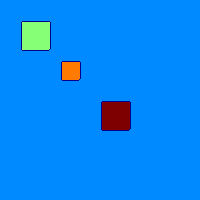Morphological Watershed Segmentation#
Synopsis#
Morphological watershed segmentation.
Results#

input.png#

output_20_3.png#
Output:
Running with:
Threshold: 20
Level: 3
Code#
C++#
#include <iostream>
#include "itkImageFileReader.h"
#include "itkImageFileWriter.h"
#include "itkScalarToRGBPixelFunctor.h"
#include "itkUnaryFunctorImageFilter.h"
#include "itkVectorGradientAnisotropicDiffusionImageFilter.h"
#include "itkVectorMagnitudeImageFilter.h"
#include "itkMorphologicalWatershedImageFilter.h"
#include "itkRescaleIntensityImageFilter.h"
#include "itkScalarToRGBColormapImageFilter.h"
#include "itkGradientMagnitudeImageFilter.h"
// Run with:
// ./WatershedImageFilter threshold level
// e.g.
// ./WatershedImageFilter 0.005 .5
// (A rule of thumb is to set the Threshold to be about 1 / 100 of the Level.)
using UnsignedCharImageType = itk::Image<unsigned char, 2>;
using FloatImageType = itk::Image<float, 2>;
using RGBPixelType = itk::RGBPixel<unsigned char>;
using RGBImageType = itk::Image<RGBPixelType, 2>;
using LabeledImageType = itk::Image<unsigned long, 2>;
static void
CreateImage(UnsignedCharImageType::Pointer image);
static void
PerformSegmentation(FloatImageType::Pointer image, const float threshold, const float level);
int
main(int argc, char * argv[])
{
// Verify arguments
if (argc < 3)
{
std::cerr << "Parameters " << std::endl;
std::cerr << " threshold level" << std::endl;
return 1;
}
// Parse arguments
std::string strThreshold = argv[1];
float threshold = 0.0;
std::stringstream ssThreshold;
ssThreshold << strThreshold;
ssThreshold >> threshold;
std::string strLevel = argv[2];
float level = 0.0;
std::stringstream ssLevel;
ssLevel << strLevel;
ssLevel >> level;
// Output arguments
std::cout << "Running with:" << std::endl
<< "Threshold: " << threshold << std::endl
<< "Level: " << level << std::endl;
auto image = UnsignedCharImageType::New();
CreateImage(image);
using GradientMagnitudeImageFilterType = itk::GradientMagnitudeImageFilter<UnsignedCharImageType, FloatImageType>;
auto gradientMagnitudeImageFilter = GradientMagnitudeImageFilterType::New();
gradientMagnitudeImageFilter->SetInput(image);
gradientMagnitudeImageFilter->Update();
// Custom parameters
PerformSegmentation(gradientMagnitudeImageFilter->GetOutput(), threshold, level);
return EXIT_SUCCESS;
}
void
CreateImage(UnsignedCharImageType::Pointer image)
{
// Create a white image with 3 dark regions of different values
itk::Index<2> start;
start.Fill(0);
itk::Size<2> size;
size.Fill(200);
itk::ImageRegion<2> region(start, size);
image->SetRegions(region);
image->Allocate();
image->FillBuffer(255);
itk::ImageRegionIterator<UnsignedCharImageType> imageIterator(image, region);
while (!imageIterator.IsAtEnd())
{
if (imageIterator.GetIndex()[0] > 20 && imageIterator.GetIndex()[0] < 50 && imageIterator.GetIndex()[1] > 20 &&
imageIterator.GetIndex()[1] < 50)
imageIterator.Set(50);
++imageIterator;
}
imageIterator.GoToBegin();
while (!imageIterator.IsAtEnd())
{
if (imageIterator.GetIndex()[0] > 60 && imageIterator.GetIndex()[0] < 80 && imageIterator.GetIndex()[1] > 60 &&
imageIterator.GetIndex()[1] < 80)
imageIterator.Set(100);
++imageIterator;
}
imageIterator.GoToBegin();
while (!imageIterator.IsAtEnd())
{
if (imageIterator.GetIndex()[0] > 100 && imageIterator.GetIndex()[0] < 130 && imageIterator.GetIndex()[1] > 100 &&
imageIterator.GetIndex()[1] < 130)
imageIterator.Set(150);
++imageIterator;
}
itk::WriteImage(image, "input.png");
}
void
PerformSegmentation(FloatImageType::Pointer image, const float threshold, const float level)
{
using MorphologicalWatershedFilterType = itk::MorphologicalWatershedImageFilter<FloatImageType, LabeledImageType>;
auto watershedFilter = MorphologicalWatershedFilterType::New();
watershedFilter->SetLevel(level);
watershedFilter->SetInput(image);
watershedFilter->Update();
using RGBFilterType = itk::ScalarToRGBColormapImageFilter<LabeledImageType, RGBImageType>;
auto colormapImageFilter = RGBFilterType::New();
colormapImageFilter->SetInput(watershedFilter->GetOutput());
colormapImageFilter->SetColormap(itk::ScalarToRGBColormapImageFilterEnums::RGBColormapFilter::Jet);
colormapImageFilter->Update();
std::stringstream ss;
ss << "output_" << threshold << "_" << level << ".png";
itk::WriteImage(colormapImageFilter->GetOutput(), ss.str());
}
Classes demonstrated#
-
template<typename TInputImage, typename TOutputImage>
class MorphologicalWatershedImageFilter : public itk::ImageToImageFilter<TInputImage, TOutputImage> Watershed segmentation implementation with morphological operators.
Watershed pixel are labeled 0. TOutputImage should be an integer type. Labels of output image are in no particular order. You can reorder the labels such that object labels are consecutive and sorted based on object size by passing the output of this filter to a RelabelComponentImageFilter.
The morphological watershed transform algorithm is described in Chapter 9.2 of Pierre Soille’s book “Morphological Image Analysis:
Principles and Applications”, Second Edition, Springer, 2003.
This code was contributed in the Insight Journal paper: “The watershed transform in ITK - discussion and new developments” by Beare R., Lehmann G. https://www.insight-journal.org/browse/publication/92
- Author
Gaetan Lehmann. Biologie du Developpement et de la Reproduction, INRA de Jouy-en-Josas, France.
- See
WatershedImageFilter, MorphologicalWatershedFromMarkersImageFilter
- ITK Sphinx Examples:
